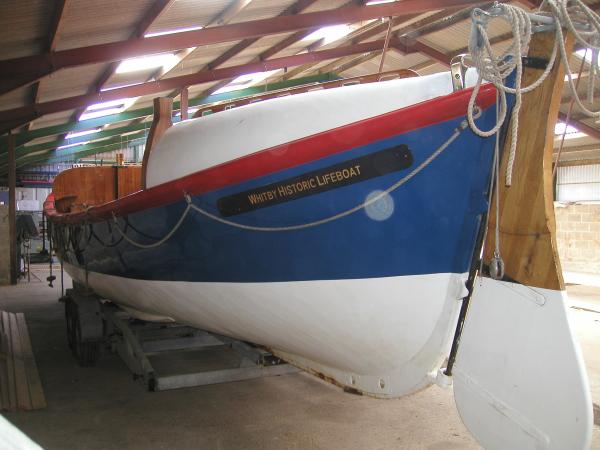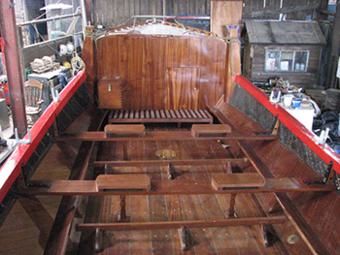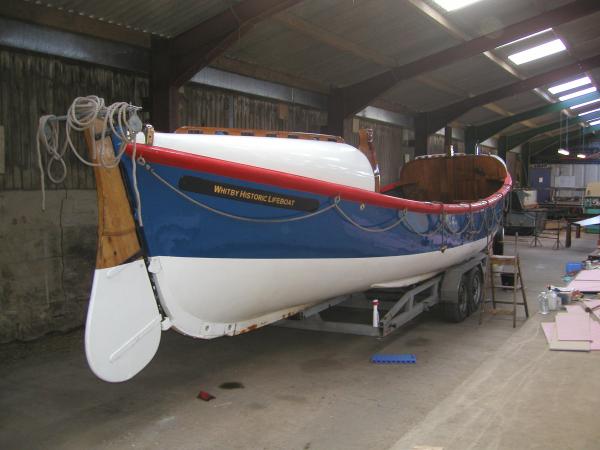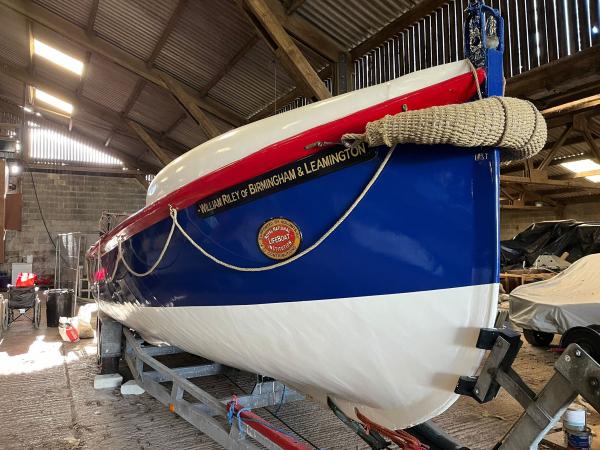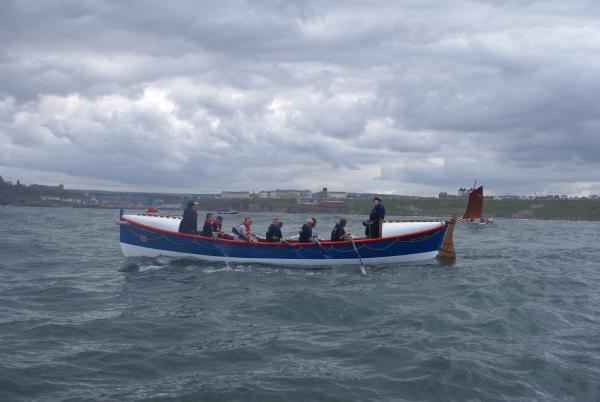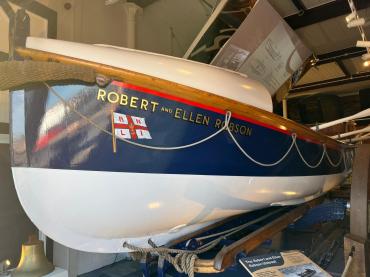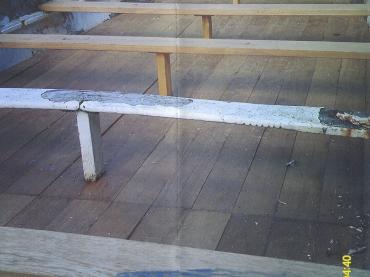

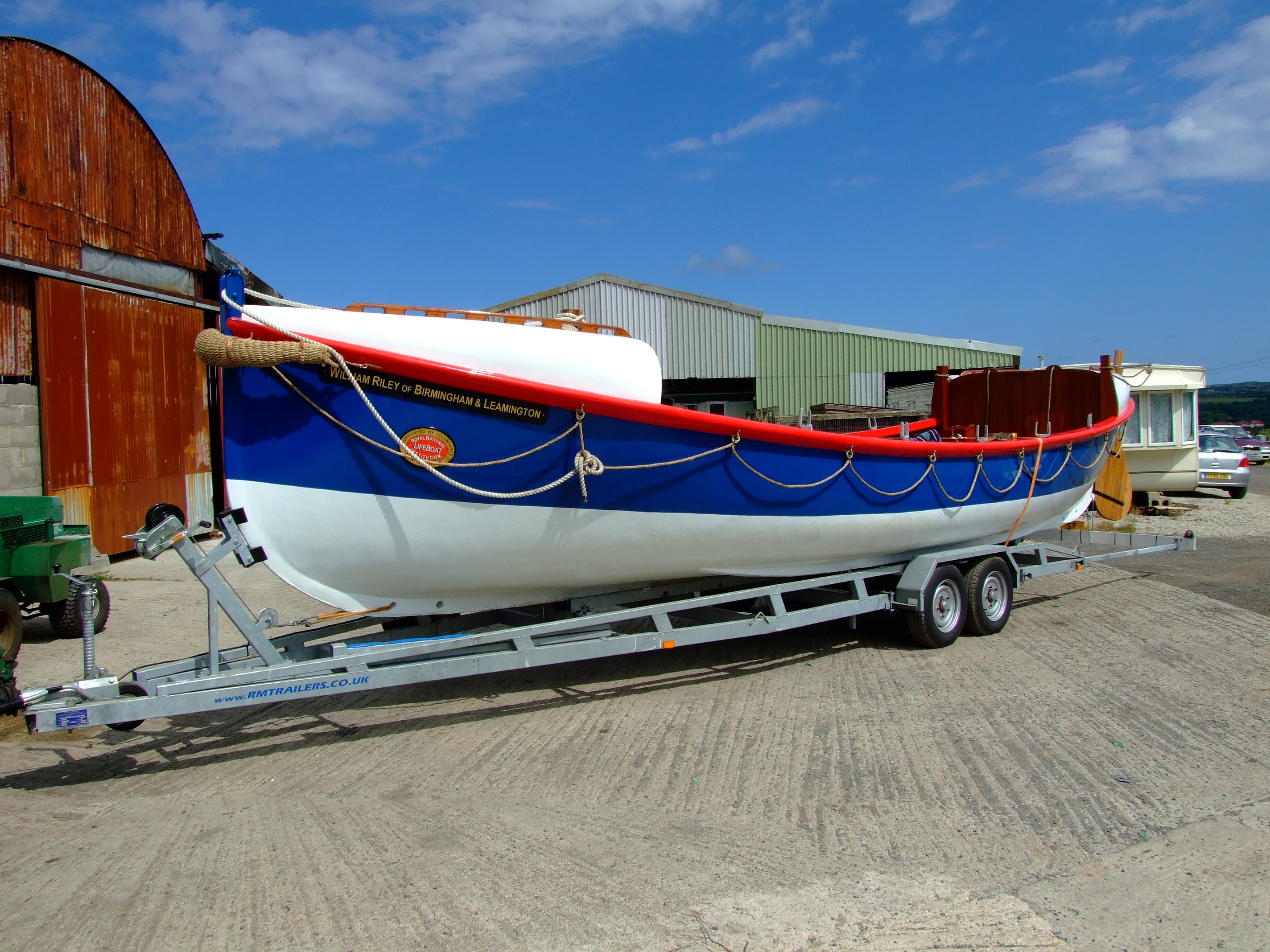
Details
Construction
Dimensions
History
WILLIAM RILEY OF BIRMINGHAM was built by Thames Ironworks on the Isle of Dogs, London in 1909 as a Thames Class Lifeboat She was paid for by a legacy from the Riley family of Leamington, and named the “William Riley of Birmingham and Leamington" at a cost of £722.9.1d. WILLIAM RILEY was first stationed in the boathouse at Upgang ravine, half a mile from the town of Whitby, North Yorkshire. The lifeboat stayed at Upgang until 1919 when she was transferred to Whitby as the No 2 lifeboat where she remained until 1931.
She is a 34 foot Thames type self-righting lifeboat with 8ft beam, 3ft 6" amidships, 6ft stern, 3ft4" thwarts, 8" gunwale, 6 relieving tubes, 5ft wooden/iron keel, 16ft bilge keels, 2 water ballast tanks, sold wood wale 5 x 3, overall weight 2 tons 6 cwts., no masts and sails, and 10 coble oars. She is believed to be one of the first boats to be painted in the darker (Oxford) blue rather than the previous lighter (Cambridge) variant of RNLI colours.
In 1914, WILLIAM RILEY was involved in the ROHILLA disaster. The SS ROHILLA was a steamship built in 1906 for the British India Steam Navigation Co. for service between Southampton and Karachi. At the outset of the First World War she was requisitioned by the Admiralty and converted into a hospital ship. On 29 October 1914 she left Queensferry near Edinburgh with a full complement of 229 people en route for Dunkirk to pick up wounded from the battlefields of France. At about 4 am on 30 October 1914, in appalling weather conditions, she struck a reef just south of Whitby harbour. Although only 600 metres from shore the extreme conditions made rescue extremely difficult.
Whitby's own lifeboat JOHN FIELDEN was the first to reach ROHILLA and took off 17 survivors on her first run and 18 on her second but was badly damaged. Several other lifeboats were called into service, including the Upgang lifeboat, WILLIAM RILEY, located two miles away. She was taken more than three miles by road and along very steep hills. Despite the efforts of her crew she could not reach ROHILLA. The rescue of the remaining survivors, including the Captain, was eventually made by the motor-powered Tynemouth lifeboat. It was the 'failure' of oar power on this occasion that finally convinced the RNLI and their crews to adopt mechanical power.
WILLIAM RILEY was sold out of service and converted to a cabin cruiser in 1931. She spent most of her life on the canals around Stowbridge. In 2005, WILLIAM RILEY was lying derelict on the River Taw near Barnstaple, Devon, when spotted by Dave Charlton for sale on Ebay. Dave bought her and donated her to the Whitby Historic Lifeboat Trust. With the help of a Heritage Lottery Fund grant of £44,800, the vessel underwent a full restoration to return her to her full 1914-era glory, and was relaunched in 2008. In 2012, she was selected for the Queen's Diamond Jubilee Pageant on 3 June.
Significance
1. What is the vessel’s ability to demonstrate history in her physical fabric?
Evidence for designs, functions, techniques, processes, styles, customs and habits or uses and associations in relation to events and people. How early, intact or rare these features are may impact on significance.
WILLIAM RILEY OF BIRMINGHAM and LEAMINGTON (ON 594) (hereafter WILLIAM RILEY) was the fifteenth Rubie self-righter lifeboat to be built, the first having been introduced in 1894, and reflects changes in design from earlier craft of this type. This form of Rubie lifeboat was designed with flatter end-boxes and an automatic water ballast tank. Her length overall was 34ft and her breadth 8ft. She was built in mahogany with double diagonal planking and two bilge keels. Although classified as a pulling and sailing lifeboat, she carried no masts, being a rowing lifeboat only and was steered by means of a retractable rudder. In 2005, WILLIAM RILEY was returned to her 1909 configuration. Weak and damaged planking on her hull, sections of the keel, gunwales and stern posts were all replaced. Repairs were made using 1mm mahogany laminate and epoxy resin and filler. The keel iron was removed, de-rusted and refitted. A new deck, bulkheads, thwarts and flotation boxes were constructed and fitted, as were new grab rails, rudders, tiller, chests, oars and coxswain’s platform. The gunwales were repaired using material from MARY ANDREW, a similar craft and her fore metal rubbing strip and fairlead were also used to replace those on WILLIAM RILEY. The hull was sheathed in glass reinforced plastic sheeting and impregnated with resin.
2. What are the vessel’s associational links for which there is no physical evidence?
Associations with people or places. Off-ship research.
WILLIAM RILEY was built in 1909 by Thames Ironworks on the Isle of Dogs in London and designed by Felix Rubie. She was paid for by the Riley family of Leamington (who later went on to found the Riley car company) and named accordingly. WILLIAM RILEY was stationed at Upgang, north of Whitby, from 1909 to 1919, and then at Whitby until 1931 giving her strong local significance to the area. She is most closely associated with the ROHILLA disaster in 1914, when the WILLIAM RILEY was taken more than three miles by road and along very steep hills to try and reach the stricken ship. This incident had a national impact, marking the end of rowing lifeboats by convincing the RNLI of the need to adopt widespread mechanical power in future. The coxswain and second coxswain both received thanks on vellum from the RNLI in recognition of their efforts.
In her role as the Whitby No. 2 reserve lifeboat between 1919 and 1931, WILLIAM RILEY was launched thirty-one times and is credited with saving ten lives. Whitby was the last lifeboat station to retain a pulling lifeboat. WILLIAM RILEY was converted to a cabin cruiser in 1931, before being discovered by Whitby Historic Lifeboat Trust 2005. In 2012, she participated in the Queen’s Diamond Jubilee Pageant on the River Thames. There is a model of her on display in the Whitby Lifeboat Museum and her service log survives, along with contemporary accounts of the ROHILLA disaster. She has been recorded on the National Register of Historic Vessels since 2009.
3. How does the vessel’s shape or form combine and contribute to her function?
Overall aesthetic impact of the vessel, her lines, material she was built from and her setting. Does she remain in her working environment?
As a standard Rubie class lifeboat WILLIAM RILEY was strongly constructed with double diagonal planking and a chunky keel. She was open-decked with end buoyancy boxes to make her as safe as possible at sea. She had a single centreboard and was crewed by a team of ten oarsmen, with oars on thole pins. Her lack of sails reflects the difficult conditions off the Whitby coast where masts were considered more of a hindrance than a help. She is an example of a lifeboat built for a particular use and adapted to the conditions she would have to face. Following conversion to private use, she has now been returned to her original form and is an aesthetically pleasing sight in her RNLI livery, particularly when being pulled through the streets in the traditional manner. She is located at Whitby where she spent her service life and continues to operate for fundraising and educational purposes.
Source: NHS-UK team, 02 April 2024
Key dates
-
1909
Built by Thames Iron Works, London for use as Upgang, Whitby, lifeboat
-
1914
Involvement in ROHILLA disaster led to change in policy regarding pulling and sailing lifeboats
-
1919
Became Number 2 lifeboat at main Whitby lifeboat station
-
1931
Decommissioned and moved into private ownership following conversion to cabin cruiser
-
2005
Discovered by Whitby Historic Lifeboat Trust lying derelict in Barnstaple
-
2008
Restored to 1914 condition with help of Heritage Lottery Fund grant and relaunched
-
2012
Vessel selected for Queen's Diamond Jubilee Pageant on 3 June 2012
Grants
-
2006/07
The Heritage Lottery Fund awarded £44,800 for restoration work
Own this vessel?
If you are the owner of this vessel and would like to provide more details or updated information, please contact info@nationalhistoricships.org.uk

